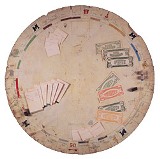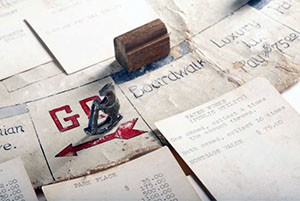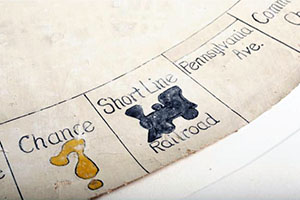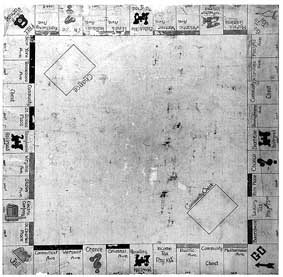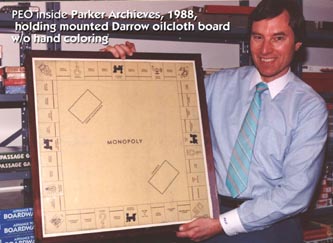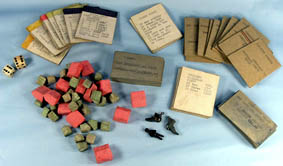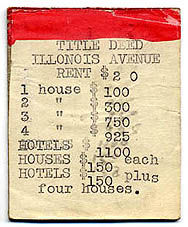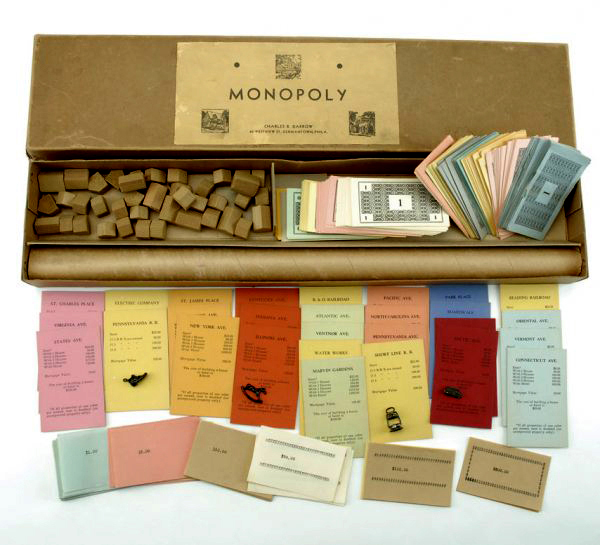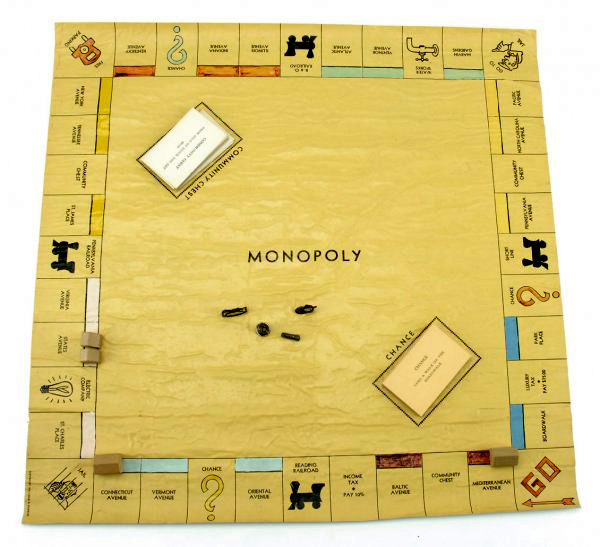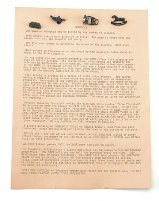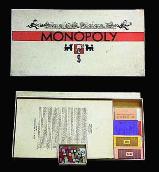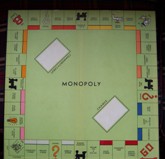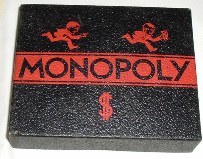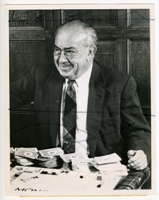Classic Versions 1933 to 1935 - Charles Darrow Editions (USA)
1933
Charles Darrow started producing Monopoly games in 1933. He started by making sets by hand for friends who came to his house to play with him and had to have a set of their own.
These first sets had oilcloth boards, hand cut houses and hotels, hand-typed Chance, Comunity Chest, and property cards, and play money and dice from a dime store (some money was hand-typed as well).
The diameter of the circular oilcloth is approximately 85cm.
Charles Darrow used a circular oil cloth, presumably the shape of his kitchen table, at first just to be different from the Quackers but he must have found out soon that retailers don't like circular games since they take up too much room.
The purchase of this set by The Forbes Magazine Galleries is described as follows in the Maine Antique Digest, Febr. 1993:
"Forbes Magazine Collection Pays Record Price for Monopoly But Has No Monopoly on Monopoly.
An original Monopoly game, handmade by Charles Darrow, probably in 1933, that descended through Darrow's brother-in-law's family sold at Sotheby's on December 16, 1992, for $ 71,500, a record for an American board game.The buyer was the Forbes Magazine Collection.
The game is drawn on a circular piece of oilcloth, probably the shape of Darrow's dining table. It is one of the earliest sets to survive, one of three calligraphic sets known to exist, and the only circular one. The rules are believed to have been supplied by a friend of Darrow's, Charles E.Todd of Germantown, Pennsylvania, who had taught the Darrows to play Monopoly. Darrow asked Todd to write out the rules as he remembered them and change anything that needed improving. Todd reportedly had his secretary make up a dozen sheets.
The record game consists of a manuscript "board" on circular off-white oilcloth, 33½" diameter, the typscript set of rules on machine-made wove paper watermarked with an interlocking VV in an oblong lozenge, and 214 playing pieces, comprising 28 deeds, 14 Chance and 14 Community Chest cards, hotels and houses made of brown-stained pine, money in $500, $100, $50, and $20 denominations printed from line blocks in green (front) and yellow, yellow-orange, or orange (back), and seven playing tokens (possibly not original).
Darrow's early calligraphic sets have generally turned up in Quaker families in the Philadelphia area. The circular one sold at Sotheby's was given in 1933 to Darrow's brother-in-law, J.Barclay Jones of Radnor, Pennsylvania and then to his mother-in-law, Emily Bishop Harvey of Radnor, and then in 1933-34 to her cousin, Margaret Bishop Dawson, from whom it descended to the consignor."
Exactly 18 years later this circular oil cloth was sold again, for more than double the purchase price, at Sotheby's as it was announced on 17 December, 2010:
A packed salesroom of toy collectors and enthusiasts watched as The Malcolm Forbes Toy Collection achieved $2,388,637 today at Sotheby’s New York. The collection of toy boats, soldiers, motorcycles and classic board games was lovingly gathered over nearly four decades by legendary collector Malcolm Forbes and his sons.
Another major highlight from today’s sale was an original Monopoly game-set of circular design, handmade by Charles Darrow, probably 1933, and descended in his family. The gameset sold for $146,500, well-above the $80,000 high estimate. It is the earliest Darrow set known to survive, the only one of circular shape, and the earliest to include the rules.
It was purchased by The Strong- National Museum of Play - Rochester,N.Y. and since 9 December 2011 on permanent display in the corner "Monopoly: An American Icon."
The board is changed to the square board
Dimensions of the oil cloth: about 80 x 80 cm
The quakers used to make their games on oil cloths, so Darrow did the same! Another proof of the fact Darrow copied Todd's game board is he copied Todd's mistake with the Marvin Gardens property as well.
The differences in finish, compared to Todd's set copied are:
There are prices mentioned on the board's spaces.
There are color bars on the street spaces.
The Chance and Community Chest spaces on the game board are next to the "wrong corners" as well. However, the spaces are well marked.
No treasure chest yet on the Community Chest spaces.
Strange question mark on the concerning fields.
The "stations" already are illustrated with todays engine.
We also recognize the car on the Free Parking corner.
However, there is a strange Jail on the concerning corner space.
The Electric Co. and Water Works spaces are illustrated with unusual illustrations.
No name of the game in the centre of the game board.
This picture of Phil Orbanes showing a framed Darrow oil cloth board was taken inside the Parker archives in 1988. Darrow would have hand coloured them after return from the printer, his friend Patterson, who mastered the art of printing on oilcloth.
This means it is one of the first boards made in series and still partly hand crafted. That is why it must have been printed late 1933-early1934 after the unique hand made game boards made by CBD and before his White Box edition, which he started to produce by the fall of 1934.
Tim Walsh writes in his book "The Playmakers" (page 49-51) about Charles' hand manufactured boards:
Taking oilcloth (a cheap fabric with a washable surface used for tablecloths), Darrow first tried making a circular game board.
He added more color to the property spaces and, more importantly, illustrations that brought the game to life. The famous black Railroad silhouettes, the red car on Free Parking, the red arrow and boxy letters on the GO space, the Water Works faucet, the Chance question marks and the pointing hand for the space marked Go To Jail did not appear on any pre-existing Monopoly games. Bill Darrow (Charles' son) contends that all of these legendary icons were the direct work of his father. "He didn't have any money to hire an artist yet. He used stencils for the railroads and the rest was all hand-painted." Phil Orbanes, former senior president of research and development at Parker Brothers, says, "Darrow gave Monopoly its first visual signature. His artist stylized the corners of the board ... and created the first copyrightable look, the look that all of America has come to know, the look that represents the game of Monopoly."
In 1933, Darrow copyrighted his version of the game and began selling homemade copies of it to friends and associates. "It took him all day to turn out a single game," Bill Darrow said. "A local lumber yard gave him some old pine moldings that he cut to make the houses and hotels." Darrow produced the game for about $1.00 and sold it for $2.00, not a bad profit in the dark days of the Depression, yet he knew he could sell more if he could make them faster. "As you can well imagine it was pretty damn labor intensive," Bill said. "He just got snowed in and it was just a matter of time before he went running down to Patterson."
"Patterson" was Lytton Patterson, Jr., a friend of Charles Darrow and owner of Patterson and White Printing in Philadelphia. To automate whatever part of the manufacturing process he could at an affordable cost, Darrow hired Patterson and White to print only the black outlines on a limited number of oilcloth boards, which he would then hand color.
With Patterson's help, Darrow doubled his output to two games a day, but demand still outpaced his ability to hand color the board, hand cut the hotels and houses, and type up the rules and game cards. When Patterson and White took over the bulk of the production, leaving Darrow to paint the boards and assemble the sets by hand with the help of this wife and young son, the entrepreneur was able to make six games a day. It still wasn't enough."
What about the components of these first versions?
On page 175 of his book "Monopoly, The world's most famous game", Philip Orbanes has following comments on these attributes:
I noticed that these cards bore a striking resemblance to the typed, hand-painted components fashioned by Charles Darrow in 1933 and early 1934. While their origine was uncertain, there were several clues. They seemed to be the work of someone in a hurry. There are misspellings ("Ilionois") and the paint on the title deeds was sloppily applied - exactly what you would expect from someone impatient with performing this task day in and day out. The typeface resembled that on the hand-typed Darrow cards on display in the Forbes Gallery.
While these clues were not conclusive, these may be rare components handmade by Charles Darrow.
However, a few years later researchers discovered the above mentioned considerations to be capable of improvement.
The most striking point is the fact that Darrow hasn't made property cards that included the phrase "Title deed" prior to November 1935. In addition Darrow's own handmade sets had the colored stripe at the bottom of each card, not the top as we see in this set. There were no cards of this type prior to the Darrow Black Box set of 1935.
So the most logical conclusion is that these attributes have been copied from an early 1936 Parker Brothers Monopoly set and moreover by someone else than Charles Darrow and ±1936 at the earliest.
He found that he couldn't keep up with demand and enlisted the help of a print shop (Patterson and White) to help.
The printer produced the black sections of the board which Darrow then hand painted to complete. These games were housed in tie boxes. These pictures show a set with later components added.
The tokens as well as the Darrow type one and two money are not original to this game. The hand typed money at the bottom of the picture would be original to this set.
In an auction on April 9, 2008, this version went for $42500. This is how the game was introduced to the bidders:
This Monopoly set is one of only two known examples of what is referred to as the 'tie box' version of this ever popular game.
The printed oil cloth 'board', which rolls around a rigid cardboard tube for storage, was hand colored by the Charles Darrow himself - the man credited with bringing the game to Parker CBD Tie-Box.Brothers.
The other known example is sometimes on display at the Hasbro headquarters. Hasbro now holds the rights to the game. The set has the full complement of property cards, 15 each of Chance and Community Chest cards, 4 figural metal tokens, along with a quantity of wooden house and hotels. Also included is a printed copy of the original type written instructions.
The first Darrow set was laid out on circular oil cloth. He later switched to a square board and when tired of hand lettering and lining the board himself he began having the cloth printed. In computer speak this would be version 2.1. This is a unique opportunity to acquire one of the iconic pieces of American board game history.
Provenance: This game was given to a lady who home-nursed Mrs. Darrow after child birth. It was consigned by the sole heir of the former nurse. For many years it sat in a closet in Easton, PA - unused since the children of the household much preferred the folding board version of the game. Board 23" sq., Box 24".
Condition Report: excellent (there is a 6" clean tear in the cloth near one corner, there is a removable tape repair on the back side which renders the tear near invisible from the front).
1934
By 1934 this still wasn’t enough to keep up with demand (an order from Philadelphia department store Wannamaker’s didn’t help the problem) so he had Patterson and White completely make 500 sets for him.
As these sold out he had another 500 made.
1935
By 1935 demand had grown to the point this time Parker Brother’s noticed the popularity of the game and made a deal with Darrow to purchase it.
The remaining stock of 5900 games went with the purchase.
